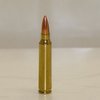I followed the directions with the seat/crimp die and ended up with a nice little crimp that looks just like the high dollar factory stuff I had. Now, for some reason I can't crimp the 5.56 without smashing the shoulder.
Unless you tiim each resized case back each time, the near .001" they grow in length can get pushed back by the seating die's crimp shoulder. You'll be better off if you make sized case mouths smaller in diameter so you won't need to crimp at all
As one of the few first couple dozen military people to shoot the M16 across the standard course of fire for service rifles at the 1971 Nationals, we all chatted about this crimp issue we knew would come up. Our brethren sitting on stools next to a bench where their bolt guns rested on supports atop a bench never crimped their 22 caliber bullets in case necks because they knew that caused accuracy problems. We decided to do the same and nobody had any bullet shift in any direction as bolt's slammed ammo against the chamber shoulder. Our 30 caliber semiauto service rifles had bullets over 3 times heavier and the weren't crimped in 7.62 NATO ammo. Their ammo slammed into the chamber shoulder faster than that of the M16 rifles did with theirs.
M1, 30 caliber 175 gr. with about .30 square inch of case neck grip, 9 fps bolt speed equals 314 ft-lbs energy.
AR15, 22 caliber 55 gr. with about .15 square inch of case neck grip, 7 fps bolt speed equals .060 ft-lbs. A 77 gr., bullet, .084 ft-lbs energy.
Bullet release force unknown, but with case neck grip pressure (psi) and friction indices the same for all, release force for 30 caliber bullets will be about twice that of 22 caliber ones.
See in the below link, the Garand cycle video at 1200 frames/second, and the one comparing it to an AR15.
https://imgur.com/gallery/3kabN
I've been called every name in the book for not testing bullets crimped in ammo for accuracy. Never had any reason to seeings how the best accuracy attained is without crimped in bullets. None of the competitive shooters getting best accuracy do it. Nor does Sierra Bullets. Figure out how to size cases so their mouths are a few thousandths smaller and that'll grip your slippery bullets tighter in case mouths and throats. Polishing down your die's expander ball a few ten-thousandths inch is a good place to start.
Ne're the less, some won't grasp this reasoning. While some do see better results from crimping, they would be better off finding out what was done wrong in their reloading to need partial fixing by crimping in their bullets.




